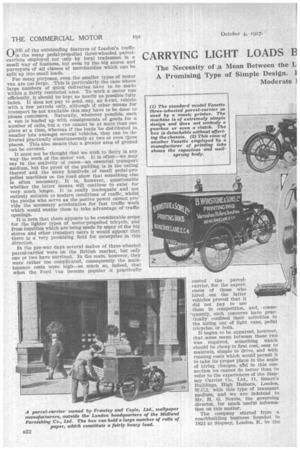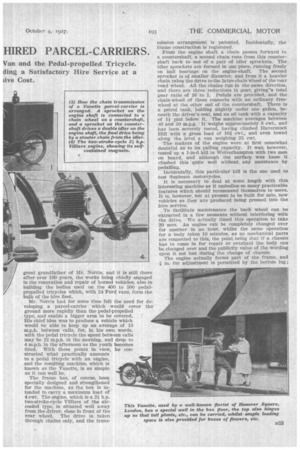CARRYING LIGHT LOADS E HIRED PARCEL-CARRIERS
Page 50

Page 51

Page 52

If you've noticed an error in this article please click here to report it so we can fix it.
The Necessity of .a Mean Between the L A Promising Type of Simple Design.
Moderate ] Van and the Pedal-propelled Tricycle. cling a Satisfactory Hire Service at a Jive Cost.
CINE of the outstanding features of London's traffic
is the many pedal-propelled three-wheeled parcelcarriers einployed not only by local tradesmen in a small way of business, but even by the big stores and purveyors of all classes of merchandise which can be split up into small loads.
For many .purposes, even the smaller types of motor van are too large. This is particularly the case where large numbers of quick deliveries have to be made within a fairly restricted area. To work a motor van efficiently, it should be kept as nearly as possible fully laden. It does not pay to send, say, an 8-cwt. vehicle with a few parcels only, although if other means for transport be not available this may have to be done to please customers. Naturally, wherever possible, such a van is loaded up with consignments of goods for a number of calls, but a van cannot be at more than one place at a time, whereas if the loads be distributed in smaller lots amongst several vehicles, they can be delivered Practically simultaneously at two or even tpree places. This also means that a greater area of ground can be covered.
It must not he thought that we wish to decry in any way the work of the motor van. It is often—we may say in the majority of cases—an essential transport medium, but the proof of the pudding is in the eating thereof and the many 'hundreds of small pedal-propelled machines on the road show that something else is often necessary. It is, (however, questionable whether the latter means will continue to exist for very, much longer. It is really inadequate and not entirely suitable to modern conditions of traffic, whilst the youths who serve as the motive power cannot pro= vide the necessary acceleration for fast traffic work which would enable them to take advantage of traffic openings.
It is here that there appears to be considerable scope for the lighter types of motor-propelled tricycle, and from inquiries which are being made by many of the big stores and other transport users it would appear that there is a very promising field for enterprise in this direction.
In the pre-war days several makes of three-wheeled parcel-carrier were on the British market, but only one or two have survived. In the main, however, they were rather too complicated, consequently the maintenance costs were high—so much so, indeed, that when the Ford van became popular it practically ousted the parcelcarrier, for the experiences of those who hired out the latter vehicles proved that it did not pay to use them in competition, and, consequently, such concerns have practically confined their activities to the hiring out of light vans, pedal tricycles, or both.
It began to be apparent, however, that some mean between these tw,o was required, something which should be cheap in first cost, easy to maintain, simple to drive, and with running costs which would permit it to take its proper place in the scale of hiring charges, and in this connection we cannot do better than to refer to the experiences of the Stepney Carrier Co., Ltd., 11, Stnart's Buildings, High Holborn, London, W.C.2, with this type of transport medium, and we are indebted to Mr. H. G. Norris, the governing director, for much useful information on this matter.
The company started from a coachbuilding business founded in 1824 at Stepney, London. E.. by the
great grandfather of Mr. Norris, and it is still there after over 100 years, the works being chiefly engaged in the renovation and repair of horsed vehicles, also in building the bodies used on the 400 to 500 pedalpropelled tricycles which, with 24 Ford vans, form -the bulk of the hire fleet.
Mr. Norris had for some time felt the need for developing a parcel-carrier which would cover the ground more rapidly than the pedal-propelled • type, and enable a bigger area to be covered. His chief idea was to produce a vehicle which would be able to keep up an average of 15 m.p.h. between calls, for, in his own words, with the pedal tricycle the speed between calls The frame has, of course, been specially designed and strengthened for the machine, as the box is in, tended to carry a maximum load of 4 cwt. The engine, which is a 2ih.p. two-stroke-cycle Villiers of the aircooled type, is situated well away from the driver, close in front of the rear wheel. The drive is taken through chains only, and the trans mission arrangement is patented. Incidentally, the frame construction is registered.
From the engine shaft a chain passes forward to a countershaft, a second chain runs from this countershaft back to one of a pair of idler sprockets. The idler sprockets are formed in one piece, running freely on ball bearings on the engine-shaft. The second sprocket is of smaller diameter, and from it a heavier chain takes the drive to the large chain wheel of the rear Toad wheel. All the chains run in the same direction, and there are three reductions in gear, givinea total gear ratio of 16 to 1. Pedals are provided, and the chain-wheel of these connects with an ordinary freewheel at the other end of the countershaft. There is a petrol tank, holding slightly under one gallon, beneath the driver's seat, and an oil tank with a capacity of 1i pint below it. The machine averages between 40 and 50 m.p.g. It weighs approximately 3 cwt., and has been severely tested, having climbed Flaversteck Hill with a gross load of 10i cwt., and even towed along the level a van weighing 25 cwt.
The makers of the engine were at first somewhat doubtful as to its pulling capacity. It was, however, tested up a 1-in-6 hill in Wolverhampton with two men on board, and although the surface was loose it climbed this 'quite well without any assistance by pedalling. Incidentally, this particular hill is the one used to test Sunbeam motorcycles.
It is necessary to deal at some length with this interesting machine as it embodies so many practicable features which should recommend themselves to users. It is, however, not at present to be built for sale, new vehicles as they are produced being pressed into the hire service.
To facilitate maintenance the back wheel can be extracted in a few moments without interfering with the drive. We actually timed this operation to take 20 sees. An engine can be completely Changed over for another in an hour, whilst the same operation for a body takes 10 minutes, as no mechanical parts are connected to this, the point being that if a chassis has to come in for repair or overhaul the body can be changed over and the publicity value of the wording upon it not lost during the change of chassis. The engine actually forms part of the frame, and in.. for adjustment is permitted by the bottom lug; any further adjustment must be made by removing links from the chains.
The box is carried on four spiral springs each with a check spring, the, standard type 'being 3 ft. 4 ins. long, 3 ft. 4 ins, wide and 2 ft 8 ins. deep There is no clutch ; consequently, when the parcel-carrier is stopped the engine does not run; thus there is no possibility of wasting fuel in this manner. To start away it is only necessary to give two or three turns with the pedals, which a demonstration has shown to be no strain on the driver.
The silencer discharges forward, but this does not have any ill effect. It is merely a matter of convenience in design.
One of the features of the construction is a steady bar, secured to the box frame, which slides between two phosphOr bronze blocks carried by the main frame ; this prevents undue stressing of the steering head.
Each machine is equipped with Avon cord tyres, 26-in. by 2i-in. for 2i-in. rims.
Now we come to the question of the cost to the user of employing such vehicles for his work. A light Ford van is hired out at £7 10s. per week, the mileage limit for this period being 250, after which extra
charges are made. Vanette parcel-carrier, inclusive of driver, costs the user a minimum figure of 1.4 per week. We say minimum because a maximum mileage of 300 is permitted for this charge, a reasonable extra
amount having to be paid for any mileage over this, but with the comparatively small carrier, mileage is not such an important matter as the number of calls made, although, occasionally, both figures are considerable. • For instance, in one case, the carrier
covers as many as 70 miles per day, making over 50 calls. The number of deliveries may be more, as it is .quite possible for several deliveries to be made at a single place of call.
It is not intended that such small vehicles should be used to run very long distances from the place of employment, and the hirer, therefore, restricts their operation to a radius of 15 miles' from the central point. The hours of working are also fixed at eight per day.
Vanettes are already being utilized by printers, wholesale tobacconists, florists, printing-ink makers, laundries, wall-paper manufacturers and music publishers, and there is BO doubt that these, or other machines of their kind, will soon become popular amongst other users. Many favourable comments upon that— use have been received. We have seen one letter in which the writer states that he finds a Vanette quite as good in London traffic as a 1,5-cwt. van, and although this may be exceptional praise there is no doubt that for light loads the motor-propelled parcel-carrier should have a useful and enlarging sphere of activity.
We knciw that already quite a number of definite applications has been made for such vehicles, their fulfilment being merely a question of production.
That such success can be gained within a few months of the inception of a scheme of this kind merely emphasises the wellknown fact that the public is always pmpared" to avail itself of any improved facilities which are provided, whether the subject be a new type of clothes peg or as means for or system of transport.
Competition will undoubtedly arise in this, as in other businesses, but meanwhile the originator has obtained a good lead.




































































































